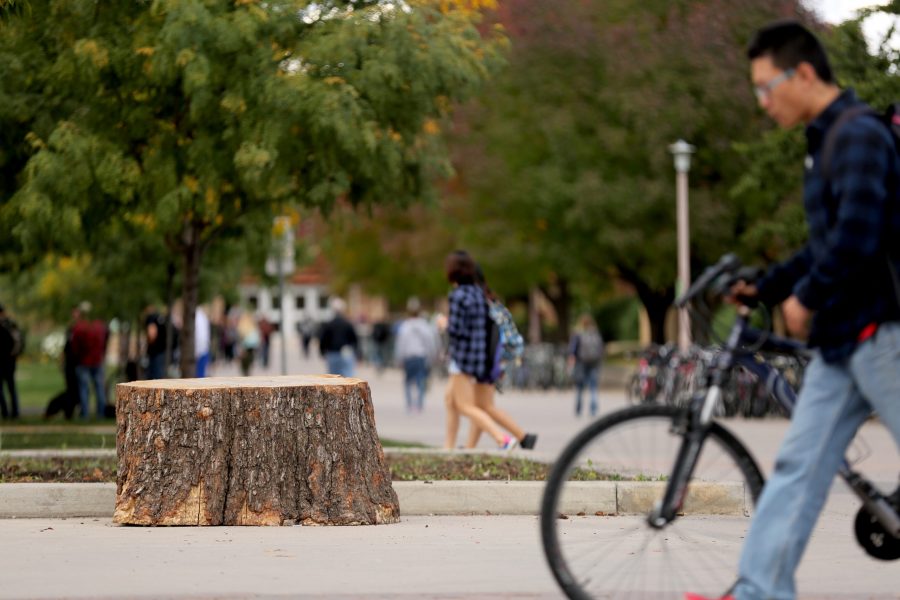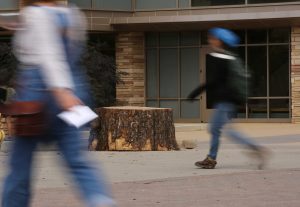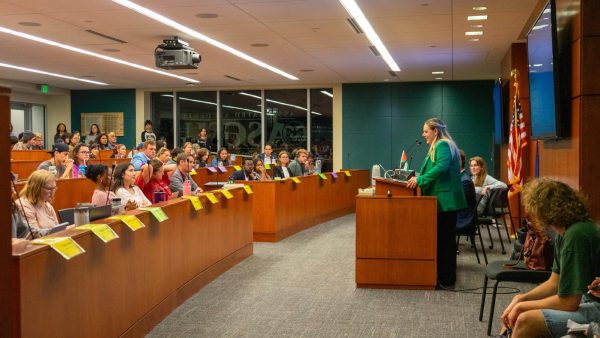Eckburg: The Stump stands as a memory of free speech’s past
Collegian | Forrest Czarnecki
The stump sits on the Plaza as students walk through between classes April 20, 2018. (Collegian File Photo)
Ren Wadsworth
February 7, 2022
It is true that the round tree stump that sits just outside the Lory Student Center stands as a University-wide acknowledgment of upholding students’ rights to free speech and protesting.
The Stump rests atop the concrete season to season, bearing the cold and heat of Fort Collins weather. In 1964, The Collegian’s former editor John Hyde and former Reach editor Shelton Stanfill bought The Stump for less than $5 to be used as a platform for free speech on campus, and it even traveled to the state Capitol two years later for a women’s rights protest.
Although it has its roots in free speech and the word “Collegian” initially carved deep into its bark, it has lost its former sheen over the years — and not just because of the elements.
With The Collegian’s transition to an alt-weekly publication and an ever-present wish to push young journalists to explore their writing and opinions, The Stump stands as a memorial of free speech’s past.
The last few years have been wrought with anger, uncertainty and restlessness. Life amid a pandemic is harder than we thought it would be, and the growing distrust in media and journalism only furthers that strife.
The United States scores low on media literacy overall, and free speech is increasingly associated with a blurring line between regulation of conspiracy ideas and protecting everyone’s First Amendment rights.
So is The Stump enough? Sure, it represents the University’s history with free speech and stands as a reminder that college campuses are places where social change is bred, but the University can and should do more.
“Making your presence physically known on campus to advocate for free speech is important, but so is maintaining accountability online, which, admittedly, is a daunting task.”
One on-campus sign reached out to students and faculty who have been affected by a free speech event on campus and offered resources to them. This raised questions for Turning Point USA campus coordinators, who felt that it represented the University’s intolerance of specific viewpoints. The sign even gained attention nationally.
This is certainly missing the point, as the resources allow students to submit bias reports if they feel like they’ve been discriminated against. It’s not that people are snowflakes, it’s that they’re honoring these groups’ right to free speech while also maintaining accountability for what they say.
You have a right to protest and speak freely, and CSU is honoring that right while also being mindful of the impact these events might have on students. The Stump itself is representative of this right, but it feels like it’s been more recently used by groups wanting to push the boundaries.
In a social media era, CSU has to do more than monitor the goings-on of The Stump on The Plaza. Free speech on campus also occurs in the digital realm, and CSU should maintain the same attitude toward it there.
The Stump is an important reminder of free speech’s past on campus, but those 1964 student media employees could not have foreseen the rapid changes the future brought us, both in technological advances and social or political shifts.
There is more outright anger now, or so it seems. Online happenings can feel louder than the voices of those on The Plaza. Making your presence physically known on campus to advocate for free speech is important, but so is maintaining accountability online, which, admittedly, is a daunting task.
The Stump is a memorial of free speech, but it feels less significant amid the chaos. Using its perceived power to push boundaries or to toe the line between free speech and hate speech can make it feel more like a curse than a blessing.
Reach Bella Eckburg at letters@collegian.com or on Twitter @yaycolor.










